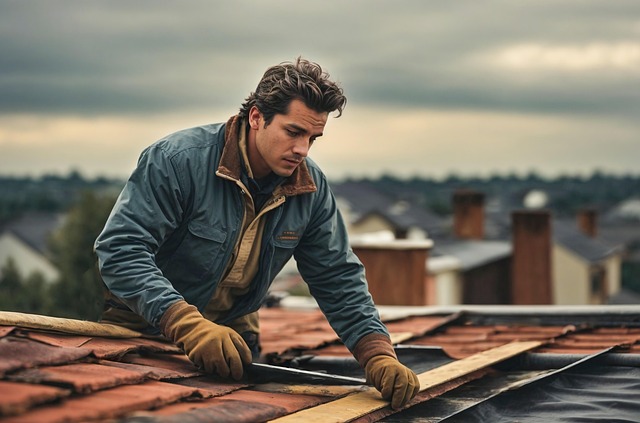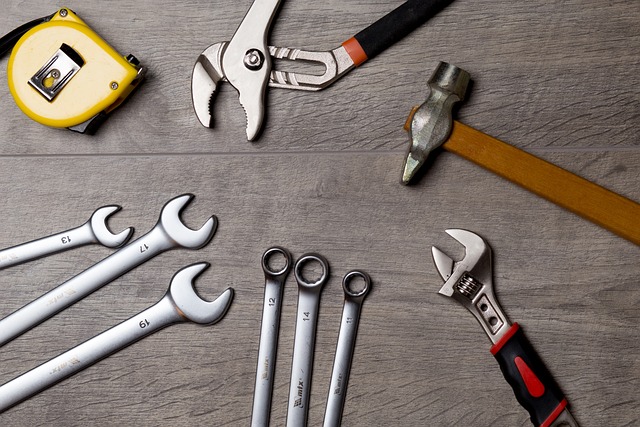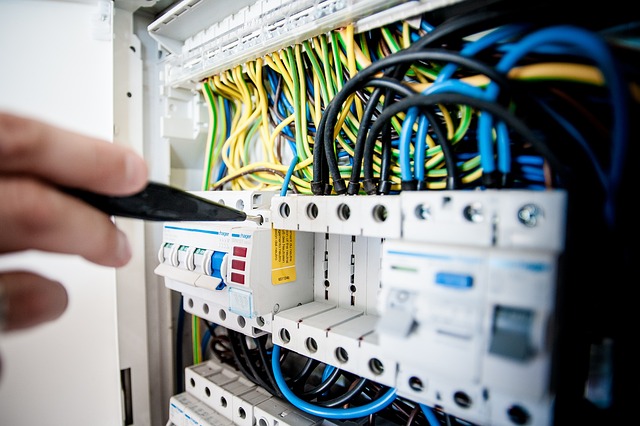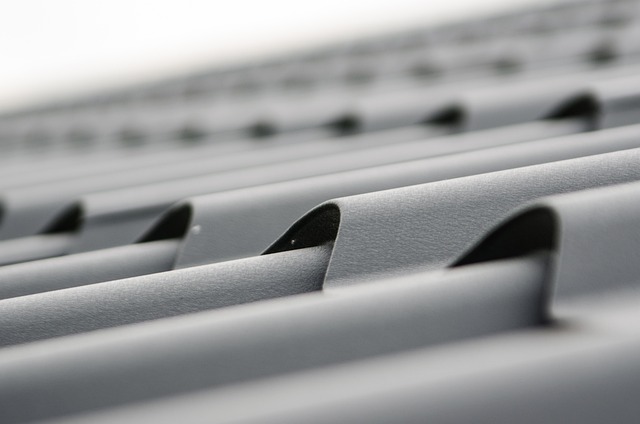Roof damage, often from aging or harsh weather, is a common homeowner concern. Early signs like unusual noises during storms and water stains indicate potential problems with shingles, flashing, or gutters. Regular inspections are crucial for identifying issues early, making repairs more manageable and cost-effective. Quick response to leaks prevents minor issues like mold growth from escalating. Essential tools for swift repairs include tarpaulins, screwdrivers, hammers, pliers, ladders, adhesives, and tar-based cements. Permanent remedies addressing root causes enhance roof durability. Safety should always be prioritized during emergency repairs, with appropriate gear and avoidance of loose or damaged sections. Ignoring complex issues like structural damage requires professional attention to prevent further problems. Regular maintenance through biannual inspections, gutter clearing, underlayment installation, and tree trimming prevents costly jobs.
Roof repairs are often an unwelcome necessity, but understanding common issues and taking swift action can significantly extend your roof’s lifespan. In this comprehensive guide, we explore various aspects of fast roof repair, from identifying early signs of damage to choosing between temporary fixes and permanent solutions. Learn essential safety precautions, when to call professionals, and preventative measures to keep your roof in top condition. Discover the importance of quick response in mitigating extensive—and costly—roof damage.
Understanding Common Roof Damage: Causes and Early Signs

Roof damage can be a homeowner’s worst nightmare, leading to costly repairs and potential safety hazards. Understanding common causes of roof damage is the first step in preventing or mitigating such issues. One of the primary culprits is aging; as your roof ages, it becomes more vulnerable to wear and tear from extreme weather conditions, including heavy rainfall, strong winds, and intense sunlight. This can result in missing or damaged shingles, which are the most visible component of a roof.
Early signs of roof damage include unusual noises during storms, such as cracking or popping sounds, which may indicate loose or missing shingles. Water stains on ceilings or walls, especially after rainfall, are another red flag. These stains could be caused by leaks stemming from damaged shingles, flashing, or gutters. Regular inspections can help identify these issues early, making roof repair more manageable and cost-effective.
The Importance of Quick Response in Roof Repairs

In the event of a roof leak or damage, a swift response is paramount for several reasons. First and foremost, timely action can prevent minor issues from escalating into major problems that could compromise the structural integrity of your home. Water intrusion, for instance, may lead to mold growth, wood rot, and even weakened beams if left unattended. Early intervention ensures these issues are identified and addressed promptly, saving you costly repairs down the line.
Additionally, quick roof repair can protect your property from further weather exposure. Depending on the severity of the damage or leak, a temporary fix or patch-up job might be necessary to shield your home until a more comprehensive renovation can be scheduled. This is especially crucial during extreme weather conditions where prolonged exposure can lead to significant structural damages.
Essential Tools and Materials for Fast and Effective Fixes

When it comes to roof repairs, having the right tools and materials is essential for a fast and effective fix. For minor leaks or damage, a well-equipped toolbox can make all the difference. Start with a high-quality tarpaulin or roofing tarp to cover the affected area temporarily, preventing further water intrusion. A set of sturdy screwdrivers, hammers, and pliers will help you remove loose or damaged shingles, while a ladder ensures safe access to hard-to-reach spots.
Don’t forget the adhesive and sealants designed specifically for roof repairs. These products create a strong bond to fix cracks, holes, or missing sections. Also, include some tar or asphalt-based roof cement, ideal for sealing leaks in flat or low-pitch roofs. With these essential tools and materials, you’ll be well-prepared to tackle common roof repair issues swiftly and efficiently.
Temporary Solutions vs Permanent Remedies: What to Choose

When dealing with roof repairs, deciding between temporary solutions and permanent remedies is crucial. Temporary fixes might offer quick relief from a leaking roof or other immediate issues, but they are not sustainable long-term options. These solutions, such as using tarps or plastic sheeting, are often easy to implement and cost-effective, but they only provide a temporary band-aid. On the other hand, permanent remedies involve more thorough investigations and repairs, ensuring the root cause of the problem is addressed. This might include replacing damaged shingles, fixing structural issues, or even re-boarding and re-shingling the entire roof. While these solutions may have higher upfront costs, they offer lasting peace of mind and protect your home from further damage.
Choosing a permanent remedy for roof repairs is particularly important when dealing with serious issues like structural damage, severe weather exposure, or aging roofs. These problems require comprehensive solutions that withstand various environmental conditions. Unlike temporary fixes, permanent remedies enhance the overall durability and longevity of your roof, ensuring better protection for your home’s interior and its occupants.
Navigating Safety Precautions During Emergency Roof Repairs

When facing an emergency roof repair, it’s crucial to prioritize safety first and foremost. Before attempting any DIY fixes or calling a professional roofer, be aware of potential hazards. Rooftops can be precarious, especially during bad weather, so ensuring you have the right equipment – like non-slip shoes, gloves, and safety harnesses if necessary – is essential for both your well-being and the quality of the repair.
During the repair process, keep clear of any loose or damaged sections of the roof, as these could cause serious injury. Also, be mindful of electrical hazards; avoid working near exposed wires and always turn off power to the affected area if possible. Effective communication is key; if you’re unsure about any aspect of the repair, consult a qualified roofer who can provide expert guidance tailored to your specific situation. Remember, a safe and swift roof repair is paramount for protecting your home and family.
When to Call in the Pros: Complex Issues That Require Expertise

When it comes to roof repairs, knowing when to call in the professionals is crucial. While minor issues like a missing shingle or a small leak can often be tackled by homeowners, complex problems demand expert attention. Signs that it’s time to bring in the pros include unusual noise during storms, persistent leaks despite temporary fixes, or noticeable changes in your roof’s structure and shape.
Structural damage, such as warped or buckled shingles, weakened trusses, or signs of rot, are red flags that require immediate professional assessment. Moreover, if your roof is older and hasn’t undergone maintenance in years, it might be beyond simple repairs and could need a complete replacement. Calling in experts ensures these complex issues are addressed correctly, preventing further damage and costly repairs down the line.
Preventative Measures: Tips for Reducing Future Roof Damage

Regular maintenance is key to preventing future roof damage and costly roof repair jobs. Start by inspecting your roof at least twice a year for any signs of wear, such as missing or damaged shingles, flashing issues, or leaks. Promptly addressing these problems can stop them from escalating.
Implementing some simple preventative measures around your home can also significantly reduce the risk of future damage. Ensure proper drainage around your roof by clearing debris from gutters and downspouts regularly. Consider installing roof underlayment to provide an extra layer of protection against elements like strong winds, heavy rain, or snow. Additionally, keeping trees well-trimmed near your house prevents their branches from weighing down on your roof or blocking essential ventilation.
